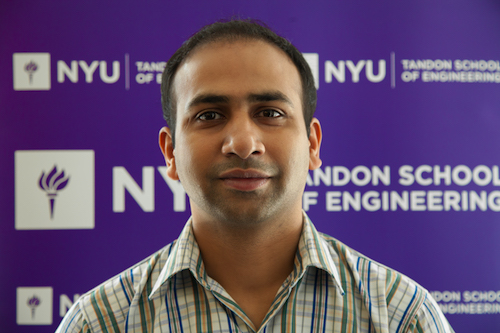Armour College of Engineering’s Department of Mechanical, Materials, and Aerospace Engineering will welcome Ayaskanta Sahu, an assistant professor in the Department of Chemical and Biomolecular Engineering at NYU Tandon School of Engineering, to present a lecture, “Hybrid Colloidal Quantum Dot Photodetectors – from X-rays to the Infrared.”
The virtual seminar will take place on Wednesday, November 17, 2021, from 3:30–4:30 p.m. Contact Elena Magnus at magnus@iit.edu for the seminar details and a link to join.
Abstract
The growing demand for creating smart and enabling devices in health, energy, information, and communication sectors requires design of novel semiconductor materials that exhibit application-specific engineered electronic properties with the potential for low-cost, large-area, and flexible devices. Colloidal quantum dots (QDs), which are nanoscale analogues of bulk crystals, offer a powerful platform for device engineers through their size-, shape-, and composition-tunable electronic and optical properties. Additionally, their surfaces can be functionalized with molecular ligands that allow bottom-up assembly into QD solids as well as impart diverse chemistry. To- date, QD solids have been used in a wide array of devices ranging from solar cells, light emitting diodes and field-effect transistors but most of these success stories have primarily been limited to the visible and near infrared region of the electromagnetic spectrum.
In this talk, I will present our recent efforts to push the envelope of the applicability of these colloidal QDs towards extremely low energy (mid-IR) and high energy (X-ray) applications. Mid-wavelength infrared (IR) photons have high penetration through airborne obscurants such as fog and mists, rendering mid- IR photodetectors ideal for use in long-distance thermal sensing and enhanced night vision applications. State-of-the-art mid-IR detectors are comprised of virulently toxic Hg, Cd and Te based compounds grown using epitaxial techniques with high fabrication costs. In contrast, I will present the synthesis, characterization, and photoconductive photodetector device characteristics of a relatively benign silver-selenide based colloidal IR material. Secondly, I will also highlight some of our recent results that show the potential of oxide and chalcogenide nanocrystals as efficient hole-blocking and photon conversion interlayers in state-of-the-art amorphous Selenium X-ray imagers and detectors for mammography.
 Biography
Biography
Ayaskanta Sahu is an Assistant Professor in the Department of Chemical and Biomolecular Engineering at NYU Tandon School of Engineering. His research focuses on investigating transport phenomena in new classes of nanostructured hybrid materials that have promise for optoelectronic and thermoelectric energy conversion. Prior to joining NYU, he was a Materials Post-Doctoral Fellow at the Molecular Foundry, Lawrence Berkeley National Laboratory in Berkeley, California. He holds a B. Tech. degree in Chemical Engineering from the Indian Institute of Technology Roorkee and a Ph.D. in Chemical Engineering from the University of Minnesota. He spent a couple of years at ETH Zurich as a visiting scientist before joining the Molecular Foundry. He is a recipient of the 2021 DARPA Young Faculty Award for contributions to infrared detector technology.
Photo will be emailed
